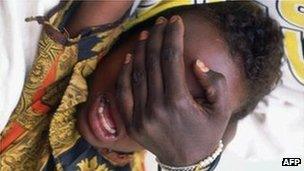UN hails drop in female genital mutilation
- Published

Female circumcision can be dangerous and can lead to health complications and fertility problems
Figures that reveal that fewer girls in Africa and the Middle East are being subjected to female genital mutilation (FGM) show it is possible to end the practice, the UN has said.
FGM, which typically involves removing the clitoris, can lead to bleeding, infections and childbirth problems.
The UN data said it was particularly in decline amongst the young in Kenya.
Kenyan women aged between 45 and 49 are three times more likely to have been cut than girls aged 15-19, it said.
In some communities female genital mutilation, also known as female circumcision, is seen as a traditional rite of passage and is used culturally to ensure virginity and to make a woman marriageable.
In December, the UN General Assembly unanimously approved a non-binding resolution calling for all member states to ban the practice.
'Deeply wrong'
The data, released by the UN children's charity and UN population fund on the international day calling for an end to FMG, showed that the younger generation was less vulnerable to female circumcision in 29 countries in Africa and the Middle East where it is usually practised.
In those countries 36% of girls aged between 15 and 19 had been cut compared to an estimated 53% of women between 45 and 49, it said.
Last year, 1,775 communities in Africa publicly declared their commitment to end the practice, the UN said.
"This progress shows it is possible to end FGM/C," Anthony Lake, Unicef's executive director said in a statement on Wednesday, external.
"FGM/C is not only deeply wrong, we can and must end it to help millions of girls and women lead healthier lives."
The BBC's Randy Joe Sa'ah reports from Cameroon, where it is estimated one in five women has been cut, that Muslim leaders signed a declaration on Wednesday saying that they did not agree with FGM.
- Published18 November 2010